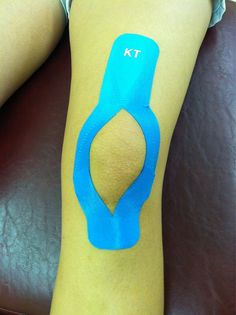NEUROMUSCULAR TAPING TECHNIQUES
- rebounds physiotherapy clinic
- Jan 13, 2022
- 4 min read

Kinesio or Neuromuscular Taping is the application of coloured, elastic, adhesive ribbons of tape onto the skin. It is a purely mechanical, non-invasive and non-pharmacological method which stimulates the tissues and promotes cell metabolism.
The tape is made of high quality cotton with an acrylic adhesive layer, stretchable lengthwise. It is hypoallergenic, breathable and water resistant and, therefore, can be widely used in sports, especially competitive ones.
It is based on the principle of correcting and facilitating skin lifting and circular motion, creating a bio-mechanical therapeutic effect on the treated area. It contributes to correcting joint alignment and posture and it is also effective in the prevention of injury, because it restores proper muscle function and dynamics. Additional features of neuromuscular taping include improving fluid circulation (blood and lymph), and reducing pain and inflammation.
When treating with Kinesiology tape,
contact between tape and body motion produces micro-movements
which stimulate receptors of the skin and underlying layers,
sending stimuli to the central nervous system
which, in turn, determine a muscle reflex response.
- The tape raises portions of the skin, dilating it so that the interstitial spaces improve circulation, favoring fluid absorption and reducing subcutaneous pressure.
- Neuromuscular Taping differs from other types of bandages in its range of application techniques depending on the desired therapeutic effect.
- Tape must therefore be applied by trained rehabilitation specialists with an excellent knowledge of human anatomy.
Theory
- The type of application theoretically determines the physiological outcome: for example, KT is applied unstretched over manually stretched skin above the injured muscle.
- This type of application will cause the skin to form convolutions which lift the skin.
- Theories suggest that these convolutions encourage regeneration of injured tissue by increasing interstitial space and alleviating interstitial pressures which occur from swelling post injury.
- This decrease in pressure also decompresses subcutaneous nociceptors, leading to decreased pain.
- It is also theorised that lifting the skin detaches filaments which attach the skin to endothelial cells of the lymphatic and capillary beds.
- This is proposed to create channels which allows for lymph to drain, thus reducing swelling and allowing increased blood flow to the area.

Basics of Application 1. Ensure to thoroughly assess the patient in order to identify the most appropriate application 2. Do NOT apply tape to any area of skin that is damaged by: scrapes; cuts; burns; sunburn or any type of skin rash/irritation 3. Skin should be free of oils and lotion prior to application 4. If body hair is limiting adhesion you may need to trim or shave the area 5. Do NOT apply with excess tension (as with zinc oxide application) 6. If patient has been exercising, ensure perspiration has completely stopped before application 7. If you are using a roll of tape, measure and cut carefully 8. Round all the edges of the tape to prevent premature peeling 9. Avoid touching the adhesive side of the tape after removing the backing as this may decrease the adhesive strength on the skin 10. Once the tape is applied, activate the heat sensitive glue by rubbing up and down the surface of the tape 11. Wait at least 1 hour after application before engaging in activity that causes sweating 12. Do not swim or shower for at least 1 hour after application 13. To dry the tape after exercising, swimming or a shower, pat gently with a towel Contra-indications and Precautions 1. Malignancy 2. Infection, cellulitis 3. Open wound 4. DVT 5. Precautions: 6. Diabetes 7. Congestive heart failure 8. Fracture Different Types of Application KT can be applied in the shape of a 'Y', 'I', 'X', 'Fan', 'Web' or 'Donut'. The shape selection depends on the size of the affected muscle and the result you are trying to achieve. 1. 'Y' tape application is generally used to: i. Surround the target muscle ii. Inhibit or facilitate muscle stimuli iii. Should be 2 inches longer than the target muscle

2. 'I' tape application is generally used for:
i. Acute injuries in place of 'Y' tape
ii. Oedema and pain (primary purpose)
iii. Alignment correction

3. 'X' tape application is generally used when:
The origin and insertion of the target muscle change depending on movement e.g. the Rhomboids

4. 'Fan/Web' tape application is used for:
Oedema (web is different because the ends remain intact)
5. 'Donut' tape application is generally used for:
Oedema (use overlapping strips and the center is cut out over the area of focus)

Insertion to Origin:
· Used to inhibit overused or stretched muscles
· Light stretch used to achieve goal
Origin to Insertion:
· Used to facilitate weak or underperforming muscles
· Light to moderate stretch required
Type of Application Stretch
The target muscle should be elongated prior to stretch. KT requires none to partial stretch to be applied on tape.
· Full - 100%
· Severe - 75%
· Moderate - 50%
· Light - 15-25%
· None - 0%
For percentage stretch refer to percentage of available stretch.
Line of pull of the tape is key
· Facilitate: proximal to distal (15-50% tension)
· Inhibit: distal to proximal (15-25%) [8]
Clinical Implications
Level of evidence - weak
What does the evidence support?
-Increase ROM
-Increase in Function
-Decrease Oedema/Swelling
Pros
Some evidence proves theories
Provides a treatment
Applicable to multiple patient populations
Feeling of treatment encourages movement
Versatile
Cons
Small body of evidence to prove theories
Expensive
Requires practice
Skin irritation
Patient After-Care Advice
· If the tape makes symptoms worse then take it off
· If the tape starts to come off then rub it to re-activate the tape adhesive
· Do NOT dry it with a hairdryer


Comments